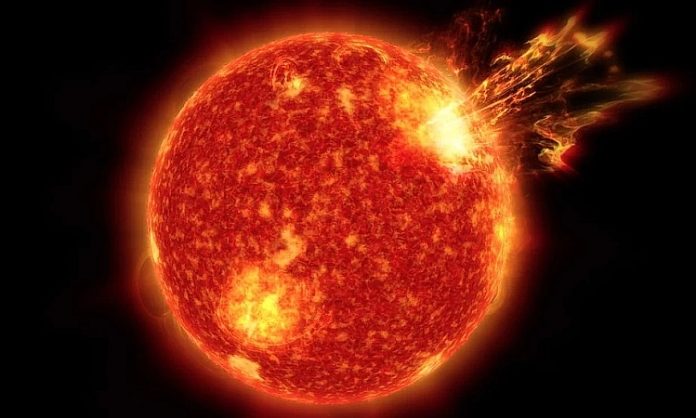New Delhi: Scientists tracking the continuous evolution of the energy state of the core of a solar eruption that occurred on July 20, 2017, have found it strangely maintained a constant temperature as it erupted energetic and highly magnetised plasma from the solar corona into space. The finding can improve the understanding of how such eruptions can impact communication systems on Earth.
Coronal Mass Ejections (CMEs) are large-scale eruptions of charged particles (plasma) and magnetic fields from the solar atmosphere into space. They can disrupt a range of ground and space-based technologies and satellites on Earth. Thus, it is crucial to understand their evolution and propagation through interplanetary space.
Also Read: Longest solar observations digitised, available for community use
There is a wide range of plasma temperatures within CMEs, from cold chromospheric material (around 104 K) to hot plasma (around 107 K). When CMEs propagate, several processes can exchange energy (electrical, kinetic, potential, thermal, and so on.), thereby heating or cooling the plasma. To understand the underlying processes, it is important to study the evolution of thermodynamic properties (such as density, temperature, thermal pressure, etc.) of CMEs. This will help our ability to monitor space weather, the scientists maintained.
In the past, scientists had studied the thermal evolution of CMEs in the solar corona. However, these earlier studies were limited to larger distances from the Sun (more than 1.5 times the radius of the Sun or RSun). It has been known that CME shows peculiar kinematics such as rapid expansion, and impulsive acceleration, in the heights below 3 times the radius of the Sun. However, the evolution of thermodynamic properties of CMEs is not yet well understood, primarily due to the lack of suitable observations in these heights.
Also Read: After OneWeb launch, ISRO eyes solar & lunar missions next year
A team of scientists consisting of Vaibhav Pant and Dipankar Banerjee and researcher Jyoti Sheoran from Aryabhatta Research Institute of Observational Sciences (ARIES), Nainital, an autonomous institute of the department of science & technology (DST), Govt. of India, and Ritesh Patel from Southwest Research Institute, Boulder, USA tracked the continuous evolution of the thermodynamic properties of the core of a solar eruption that occurred on July 20, 2017.
In a study published in the journal Frontiers in Astronomy and Space Sciences journal, they estimated the temperature and density of this CME core and found that strangely the CME core maintains a constant temperature as it propagates from 1.05 to 1.35 Rsun despite the expected adiabatic cooling due to the expansion of the core.
Also Read: Scientists develop smart material to harness solar energy for use in robotics
They used data from the ground-based instruments MLSO (Mauna Loa Solar Observatory) /K-Cor (K-cronagraph) and MLSO/CoMP (Coronal Multichannel Polarimeter) as well as data from the space-based SDO (Solar Dynamics Observatory) /AIA (Atmospheric Imaging Assembly) telescopes for the purpose and also established that the density of the CME core decreased by a factor of around 3.6 as it propagated outwards. The authors conclude that the expansion of this CME core behaves more like an isothermal than an adiabatic process (thermodynamic process in which there is no exchange of heat from the system to its surrounding).




